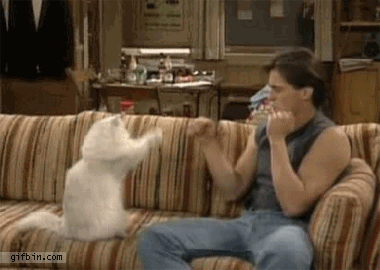Gmail : Client de messagerie géant
Produits iconiques épisode 004
There’s no denying it: Gmail is huge.
With more than 1.2 billion monthly users, Google’s email client has grown significantly in the past 14 years and continues to dominate the market as one of the most-used email clients in the world.
But what makes Gmail such an iconic product? Let’s dive right in!

Une offre incroyable
Le lancement de Gmail en 2004 n'a pas été des plus orthodoxes.
At a time when you paid for email services such as AOL and had to spend a ton of time searching for things in Outlook, Gmail completely revolutionized something that seemed so unexciting and routine: your email inbox. 📧
The press release announcing its launch was dated for April 1 — so many thought it was simply an April Fools’ Day joke.
It also didn’t help that some of the features of Gmail seemed unbelievable or, at the very least, too good to be true.
For example, Google offered 1 GB of free storage for each Gmail account — this was an amount of free storage space that was simply unheard of at this point in time. To put this in perspective: this was 500 times more storage than what Microsoft’s Hotmail offered (yes, Hotmail only gave you 2MB per account at the time). 😱

According to an interview with Gmail’s first product manager, Brian Rakowski, the April 1 launch was intentional. He said that the “ultimate April Fools’ joke was to launch something kind of crazy on April 1 and have it still exist on April 2.”
Gmail, avec son espace de stockage incroyablement vaste, son interface conviviale, ses fonctions de recherche et bien d'autres choses encore, a changé la donne en matière de messagerie électronique dès son lancement.
Google — and more specifically, Paul Buchheit — worked on Gmail for nearly three years before consumers could use it, and it was one of the first (if not the first) major cloud-based apps that could replace conventional PC software. 💽
En s'appuyant sur la technologie web pour créer son programme de messagerie électronique, Google a fait en sorte que Gmail ressemble à un véritable logiciel plutôt qu'à une suite de pages web, grâce à l'utilisation de JavaScript.
There were instances in which the project could have just been abandoned altogether. Internally, Googlers were hesitant about the concept for a variety of reasons — so it’s incredible that it even became a product in the first place.
Free email inbox — meet AdSense
Google AdSense, le produit qui analyse les messages pour trouver des mots-clés susceptibles d'être utilisés à des fins publicitaires, a été prototypé lors de la création de Gmail.
This tool sparked a debate around online privacy that still continues to this day (and is, of course, making headlines in recent months, thanks in part to things such as GDPR and the Cambridge Analytica scandal). 🔒
C'était pourtant l'une des idées de Gmail à ses débuts : créer un système qui analyse le texte des courriels afin que Google puisse diffuser des publicités à côté.

According to Marissa Mayer herself, she almost prevented AdSense from ever coming to light. 😳
While she was initially against having ads in Gmail, Buchheit supposedly stayed up all night finishing the product and Mayer saw ads everywhere the next day — and they were well done and well targeted.
En résumé, M. Buchheit avait trouvé le moyen de scanner du texte qui correspondait à des publicités déjà achetées par des clients pour des requêtes de recherche. Les cofondateurs Larry Page et Sergey Brin ont vu le produit peu de temps après, et la société a décidé d'appliquer la technologie à d'autres sites web que Gmail.
This product is what we now know as AdSense, one of Google’s largest sources of revenue.
So, to put it simply: the work that made Gmail free by developing targeted ads next to it didn’t just change the business model for email services, it indirectly changed the business model for a lot of websites based on ads. 🆓
Réinventer Gmail
As you’ve probably already heard (or seen for yourself), Google recently released a new redesign of Gmail. 🤗
Le courrier électronique est toujours d'actualité, mais les clients de messagerie ont connu une certaine stagnation ces dernières années.
While it definitely has a more sleek and modern feel, following that of Material Design, it’s not a drastic difference from the last interface.
In fact, it almost looks like a combination of Gmail and Inbox (more on that in a minute). The new Gmail is clean, visual and packed with new features. 😍
Parmi ces fonctionnalités, citons la mise en veille des courriels pour qu'ils réapparaissent dans votre boîte de réception des heures ou des jours plus tard, des suggestions de réponses intelligentes dans chaque fil de discussion et la possibilité de charger des widgets d'autres applications sur le côté droit de l'écran (vous pouvez ainsi utiliser Tâches et Calendrier pendant que vous êtes dans un fil de discussion).

Beyond these new features, it’s apparent that Google is focusing more on both productivity and security.
Google WorkspaceDepuis des années, Google est derrière Microsoft en termes de logiciels de productivité pour le travail, mais il semble que Google tente de s'approprier cet espace avec son nouveau design et ses nouvelles fonctionnalités.
In an interview with The Verge, Jacob Bank, lead product manager for Gmail, said that Google’s redesign was done with a focus on “making people safer and more productive,” both important aspects in appealing to business users.
It certainly looks like we’ll be seeing Gmail move even more toward a business focus in due time. 💼
Une expérience web ultra-rapide
One of Google’s main priorities when creating a new product is that it’s fast. User experience is at the heart of everything Google creates, and Gmail is no exception. 🏃
Even though they were the next big, exciting thing, web apps were slow and clunky around the time of Gmail’s launch. So, Google’s attention to a fast response time and high performance was a major development in the world of web apps.

Gmail, like all Google products, was built with the RAIL model in mind. RAIL is a “user-centric performance model that breaks down the user’s experience into key actions.”
Ils expliquent ensuite que le cycle de vie de chaque application web comporte quatre aspects spécifiques, et que les performances de l'application s'y intègrent de différentes manières. Il s'agit de la réponse, de l'animation, de l'inactivité et de la charge.
This model helps designers and developers focus on what’s most important: making your users the focal point of your performance effort. 🚀
With these four elements of an app’s lifecycle, Google has the following guidelines:
- Réponse : réponse en moins de 50 ms
- Animation : production d'une image en 10 ms
- Temps d'inactivité : maximiser le temps d'inactivité
- Chargement : diffuser du contenu et devenir interactif en moins de 5 secondes
A separate product for early adopters
Comment pouvez-vous créer un produit qui attire les masses, ainsi que les adeptes de la première heure, si votre produit est quelque chose pour lequel les gens se sentent généralement conservateurs ?
The Gmail solution: create a separate product for early adopters, built on the same infrastructure. 👍
Boîte de réception de Gmail is an email service that was developed by Google and launched by-invitation-only in 2014 (later launching to the public in 2015). It’s a product that came from the Gmail team, and it serves, according to Google, as a “completely different type of inbox, designed to focus on what really matters.”
It’s essentially a version of your Gmail inbox without all of the clutter. Inbox identifies and categorizes your emails so that you can quickly see what needs to be addressed and what can be archived or saved for later. ✅
Gmail is the classic version, which only gets features as soon as they are perfected and can be delivered without people freaking out about how Gmail has changed — which can probably explain why there seems to be quite a bit of Inbox influence in the Gmail redesign.
La décision de séparer Inbox de Gmail découle en fait d'un point de discorde assez dramatique chez Google.

The Google engineers, testing out potential new designs (similar to Inbox), hated the fact that the more advanced features were missing and felt like the designers were ruining Gmail. It actually got to the point that the head of Gmail’s design team created a presentation called “You Are Not the User,” detailing every design/feature decision the team made based on data.
After more drama and back-and-forth about it, they reached a compromise. They decided to streamline Gmail while keeping the advanced features available for those who wanted them. 👩💻
Inbox is quite useful for those of us who need to go through hundreds of emails a day — and it certainly helps keep your email experience a bit more pleasant and organized.
With all this in mind, Gmail is a product many of us use in our daily lives, so we’re excited to see what else Google has in the works for transforming the way we email! ✨
Enjoyed it? Read on about other Iconic Products. 📲
Vous aimez Gmail ? Consultez notre top Gmail CRM.
Nous espérons que cet article vous a plu. Si c'est le cas, passez le mot !
Pour en savoir plus sur les startups, le marketing de croissance et les ventes :
- 22+ Best Sales Podcasts You Should Check Out in 2024 - décembre 21, 2023
- Scripts d'appel à froid pour les êtres humains - 21 septembre 2023
- Les 25+ meilleurs outils de vente pour aider votre équipe à réussir - 10 août 2023
